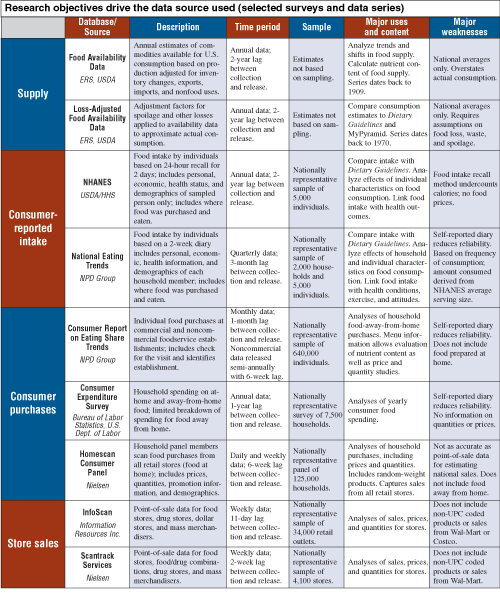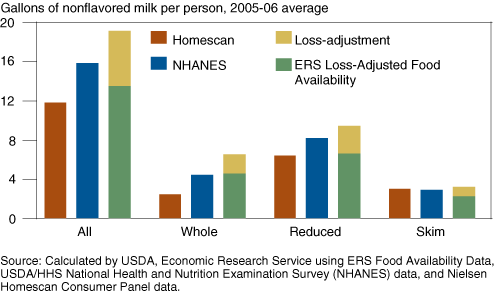Data Feature
- by Rosanna Mentzer Morrison, Travis A. Smith and Biing-Hwan Lin
- 3/1/2009
Got Data? Multiple Data Sources Track U.S. Food Consumption
Health professionals, farmers, food companies, and policymakers want to know what Americans are eating, both the type of foods and how much. But charting the eating habits of 300 million people is not easy. Researchers rely on a number of surveys and data sources, each with strengths and weaknesses. Some data sources depend on production or sales statistics, and others rely on consumers to report what they eat. Some surveys report food bought at grocery stores and other retailers (food at home), while others capture purchases in fast food places, restaurants, and other eating places (food away from home).
ERS food availability data measure the flow of raw and semiprocessed food commodities through the U.S. marketing system. Going back to 1909 for most commodities, the food availability data are useful for understanding national trends in food consumption and for calculating the approximate nutrient content of the food supply. Adjusting U.S. production for exports and imports, seed and feed use, beginning and ending inventories, and industrial uses yields the amount of a commodity available for domestic consumption. To get closer to actual consumption amounts, ERS produces a second data series that adjusts the availability data to account for spoilage, plate waste, and losses from nonedible parts (see table below).
Surveys are another way to measure consumption or intake. Food intake surveys, such as the National Eating Trends Survey, rely on consumers keeping food diaries or, in the case of the National Health and Nutrition Examination Survey (NHANES), being asked to recall what they and their families ate during the previous 24 hours. Reporting bias is a potential shortcoming of diaries and recalls; for example, consumers may over-report their intakes of nutritious foods or under-report less healthy foods. NHANES also collects information through a physical exam on respondents’ height, weight, blood pressure, cholesterol levels, and other health markers, making the data useful for examining the relationship between food consumption, diet, and health conditions of the U.S. population.
Using consumer purchase surveys, such as Nielsen’s Homescan Consumer Panel, or grocery store sales data from such surveys as InfoScan and Scantrack Services, researchers can analyze what consumers purchased, but not necessarily what they ate, particularly if spoilage or waste is high. Homescan is unique in that it contains both quantity and expenditure data; however, it does not include information on food eaten in restaurants or institutions, such as hospitals and schools. Surveys like NHANES and Homescan, which collect demographic information about survey participants, can be used to determine consumption patterns for specific demographic groups. Researchers choose the data set that is best suited for the focus of their study.
To discover how closely the different consumption estimates derived from these data sources track each other, ERS researchers compared in the following charts, three foods and three data sources: ERS Loss-Adjusted Food Availability, NHANES consumer recall, and Nielsen Homescan Consumer Panel data.
Nonflavored milk
- ERS data indicate that the average American drank 13.5 gallons of milk per year in 2005-06, compared with 15.9 gallons for people recalling their milk consumption for the NHANES interviewer. This difference could arise from NHANES respondents inflating their consumption of reduced-fat milk, or from over-estimation of loss in the ERS data.
- It is not surprising that the Homescan measure is lower (11.8 gallons per person) because it does not capture milk provided by schools or consumed in restaurants.
Fresh tomatoes
- ERS data report the highest total for fresh tomato consumption at 10.6 pounds per person, compared with 8.8 pounds in the NHANES data. When tomatoes are used as an ingredient in a food, such as stew or salad, NHANES respondents will report eating the stew or the salad, not fresh tomatoes, thus under-estimating fresh tomato intake. Also, ERS may be under-estimating loss for fresh tomatoes.
- The lower 4.5 pounds per capita from the Homescan data point out the importance of fresh tomatoes—salads, salsas, and sandwich toppings—in the foodservice sector. According to NHANES, 36 percent of fresh tomatoes are eaten away from home. Even after accounting for the away-from-home market, the Homescan consumption amount is lower than expected when compared with the ERS data.
Potato chips
- Intake of potato chips from NHANES (3.61 pounds per person) is quite similar to the ERS measure (3.68 pounds). The small difference between intake and adjusted availability likely reflects improvements in NHANES survey techniques for helping respondents recall their intake of foods known to be under-reported.
- Homescan data show at-home purchases of potato chips at 2.14 pounds per person, a relatively low number that does not include chips eaten at restaurants or institutions.
You may also like:
- Food Availability (Per Capita) Data System. (n.d.). U.S. Department of Agriculture, Economic Research Service.
- Food and Nutrition Assistance Research Reports Database - Extramural Project Database. (n.d.). U.S. Department of Agriculture, Economic Research Service.





